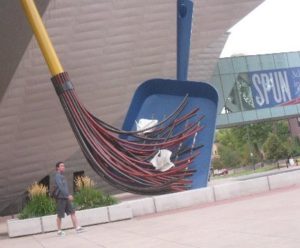You might have had it happen. You are working in the gallery, grimacing at the amount of dust that’s built up, gently stroking a brush across an object’s surface with vacuum in hand, and a well-meaning supporter or visitor mouths at you over the noise of the machine: “can you do that at my house?” It’s a great opening to talking about the bigger picture of collection care (read my post on museum dust). It’s worth stopping. But in five minutes it can be hard to talk about risk assessment, collections project management, preventive conservation, integrated pest management, and so forth. The visual of you dusting is lasting.
But that doesn’t mean we shouldn’t try. Our supporters deserve a full explanation instead of a sanitized (ha) version of museum work. They can’t be expected to fund those activities of which they are not aware. Here’s a short post on the Denver Art Museum’s website about gallery maintenance. If anyone needs to understand collection care and its necessity in preservation and continued access to collections, it is our supporters. But how do we get that message across in a way that doesn’t make their eyes glaze over or confuse them more?
We need to practice.
Collection care is the big picture of all those things we do to prevent damage. It can be difficult for those people not charged with it to understand its purpose.
Humans are by nature reactionary, not proactive. Curatorial projects generally take place over a few years, while collections managers’ work, while daily in nature, results in impacts over a hundred years. It’s difficult to institute proactive systems without knowing exactly what you are putting in and what you are getting out (and how that improves on the current system of just get it clean).Without education of our staff and supporters, they can only react to the dust they see, and naturally, we think “it’s dusty. It must be dusted!” Dusting artworks that get dirty is a necessity, but why did they get dirty in the first place? Are they under an HVAC diffuser not fitted with a filter? Do they have a fragile surface that would be better served under Plexi-glas, or at least a low plexi rail that prevents dust rising from the floor onto the platform? Is there carpeting in the gallery? And ultimately, how much ongoing damage is being caused by repeated brushing of dust from the surfaces of fragile works? Without proper documentation, we can’t see “is that red pigment in that photograph from 40 years ago? I don’t think that exists today,” because it was lost to the dusting brush.
Administrations like to staff problems (someone to protect liability, someone to fix the HVAC when it breaks) rather than hiring people to plan to avoid problems through research, planning, and assessment. Here, I’m speaking only about dust. But collection care incorporates mitigation strategies to myriad risks, including pests, environment, physical forces, light, proper documentation and security controls, and so forth. Without mitigation of any one of these risks, loss to collections, and our ability to interpret them and present them to the public, occurs.


Excellant article. I have been a advocate and creater of cleaning programs over the years in my museum collection care career. It is hard enough to schedule staff time and enthusiasm to support and conduct such work but once established the rewards on so many fronts are amazing! We need more research on affective methods and risk assessment so it can be sold to the management the importance of doing this preventive actiivty. Can there be more workshops, sessions conducted and articles written? I can help from the organizational side of iideas but do not have the conservation background for the techincal aspects. Sorry for this scribbled note via my phone but am traveling. Thanks Becky for this and all of your enjoyable bogs.
Happy Holidays
Brent Powell
Thanks for the compliments Brent! And great ideas. I agree, how do we get more research on the impact of collection care over long periods of time, versus short term treatments after the damage is already done? How do we make the information more readily accessible to those who manage/perform collection care, and how do we attract administration to support it? All important ideas. Happy Holidays to you as well!
If there is a will there will be a way. Selling managemet is hard but as with all good ideas persistance and creativity will make it happen. Hope this coversation will continue.
your publication regarding museums is very interesting…..